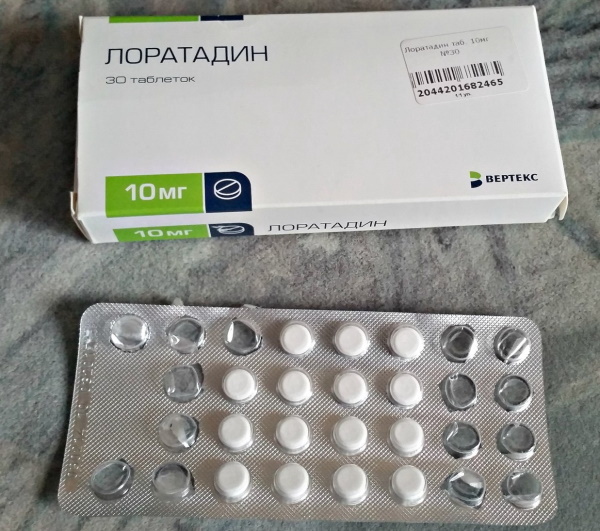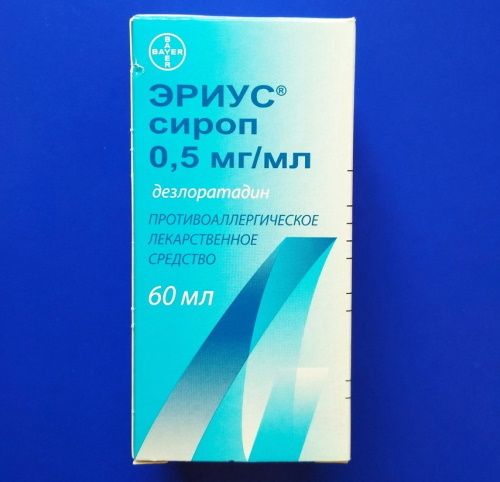Content
- Release form
- Chemical composition
- Pharmacological properties
- Pharmacodynamics and pharmacokinetics
- Indications for use
- Contraindications
- Drug safety
- Instructions for use when breastfeeding, dosage
- Side effects
- Overdose
- special instructions
- Drug interactions
- Analogs
- Terms, conditions of sale and storage
- Price
- Video about the drug Loratadin
Loratadin is a domestic drug to eliminate or prevent the development of allergies and its symptoms. The remedy is distinguished by the speed and duration of action, the low probability of provoking side effects. These characteristics allow women to use the drug while breastfeeding, but subject to special conditions.
Release form
Loratadine comes in 2 forms: tablets and oral syrup. The first form of release is presented in the form of small flat round tablets of white color with a dividing line in the middle (on one side) and with beveled edges. The product is packed in cellular blisters of 10 pcs. A cardboard package may contain 1 or 3 blisters and instructions for use.
The second form is presented in the form of a transparent liquid with a slightly yellow to bright yellow color and a light fruity aroma. The syrup is placed in bottles made of dark plastic, or glass, with a screw cap, in the amount of 100 ml. In the carton, in addition to the bottle and instructions, there is a measuring spoon.
Chemical composition
The active substance in both types of the drug is loratadine, which contains 10 mg and 100 mg in one tablet in 100 ml of syrup. In addition to the main element, the preparation contains additional components, which are indicated in the table below.
Minor components of Loratadine tablets and syrup:
| List of elements | Description of the components |
| Pills | |
| Lactose monohydrate | Preservative. In addition, the substance improves calcium metabolism, normalizes the intestinal flora, as well as the activity of the heart and blood vessels. |
| Microcrystalline cellulose | The component gives the tablets the desired texture, prolongs the effect of the active substance and improves its absorption. In addition, MCC improves the functioning of the digestive tract. |
| Calcium stearate | It is a thickener and is used to shape tablets into desired shapes. |
| Sodium carboxymethyl starch | Used as a thickener and shape stabilizer. |
| Syrup | |
| Sucrose | Gives the syrup a sweet taste and is a preservative. |
| Propylene glycol | A solvent with bactericidal properties. |
| Benzoic acid | Preservative with antiseptic properties. |
| Lemon acid | A preservative that gives the syrup a pleasant sourness. In addition, the substance has an anti-inflammatory and bactericidal effect, strengthens blood vessels and normalizes digestion. |
| Ethanol | Antiseptic preservative. |
| Tropeolin dye | The substance gives the syrup a pleasant yellow tint. |
| Orange flavor | The flavoring gives the syrup an orange scent while masking the smell of other ingredients used. |
| Purified water | Used to combine used elements. |
 Minor components not only give the medicine the desired shape, but also prolong its shelf life.
Minor components not only give the medicine the desired shape, but also prolong its shelf life.
Pharmacological properties
Loratadine belongs to the group of antihistamine drugs.
Pharmacodynamics and pharmacokinetics
Loratadine when breastfeeding can only be used with the permission of a specialist. This limitation is justified by the fact that the active substance of the drug penetrates into breast milk, which means it also enters the baby's body.
The components included in Loratadin have the following effect on the body:
- blocks the sensitivity of histamine receptors. This action prevents the development of allergies or eliminates its symptoms, if the pathology has already manifested itself;
- reduces the severity of itching;
- has a positive effect on the condition and work of blood vessels and heart;
- reduces the formation of exudate in the area of tissue damage;
- reduces tissue swelling;
- eliminates muscle spasms.
If the allergy manifests itself in a severe form, then the drug cannot completely eliminate all the symptoms, but significantly reduces their manifestation. The advantage of the drug is a gentle effect on the organs of the digestive tract.
The therapeutic effect of taking the medication is noted approximately 30 minutes after its use, and lasts up to 24 hours. The peak of the drug's effectiveness occurs after about 10 hours of taking it. If the use of Loratadine is combined with a meal, then the therapeutic effect occurs later, by about 1 hour. The active substance is completely excreted from the body approximately on the fifth day (with urine and feces).
Important. The drug is not addictive, severe drowsiness, does not affect the cells of the nervous system. In addition, the drug stands out (from the first generation groups) with a long-term therapeutic effect.
Indications for use
Indications for the use of Loratadine during lactation are as follows:
- severe seasonal allergy, accompanied by a profuse flow from the nose. Severe rhinitis is dangerous for the development of otitis media;

- conjunctivitis of an allergic nature. Pathology is accompanied by increased lacrimation and rhinitis, and the risk of eye infections increases;
- hives in moderate to severe form. With a bright form of the disease, there is a high probability of severe swelling of the internal organs, which can be life-threatening;
- Quincke's edema;
- eczema in chronic form with severe symptoms;
- elimination of symptoms of a pseudo-allergic reaction;
- development of bronchial asthma;
- severe itching of any nature. As a result of severe itching, the epidermis is injured, and the regular desire to scratch provokes the development of anger and irritability.
In addition, Loratadine can be used to eliminate an allergic reaction caused by an insect bite.
Contraindications
During lactation, Loratadine cannot be used if the mother and child have the following prohibitions:
- intolerance to the composition of the mother and child;
- disruption of the liver or kidneys, even in a mild form;
- it is undesirable to take Loratadin until the baby is 1 month old.
The listed contraindications must be checked in the child, since the active substance penetrates into breast milk.
Drug safety
Loratadine is not completely safe when breastfeeding. But in cases where an allergic reaction poses a danger to the health of the mother, the drug is prescribed by a doctor. If it is necessary to take the drug in high doses (severe allergic reaction), while using the medication, it is recommended that the baby be transferred to artificial feeding.
The following describes the safety of Loratadine for mother and child:
| The safety of the medication during lactation | |
| For mother | The use of the drug can cause the development of side effects only in rare cases (non-compliance with the dose, very long intake). A negative reaction to Loratadine does not pose a strong health hazard. |
| For a child | With mother's milk, the baby receives a small amount of the drug (approximately 0.012 mg, when used mother 2 tablets), which in extremely rare cases can cause mood swings and changes in the child appetite. |
Important. It is strictly forbidden to take Loratadin without a doctor's prescription.
Instructions for use when breastfeeding, dosage
Loratadine is an effective drug, the use of which in rare cases is accompanied by the manifestation of side effects. But due to the fact that the main element penetrates into breast milk, and there are no tests on the dangers of the drug infants during lactation, taking medication during breastfeeding (dosage and course) is prescribed strictly a doctor.
Dosing features of Loratadine during lactation, depending on the purpose of use:
| Purpose of admission | Dosage per day | Well | Notes (edit) |
| Seasonal allergies | ½ tablet or 5 ml of syrup. Take in the morning. | 10-30 days | If long-term use is required, a doctor's permission is required. |
| Allergic conjunctivitis | ½-1 tablet or 5-10 ml of syrup. Consume in the morning. | 5-14 days | Complex therapy is prescribed, which is established by a specialist. |
| Hives | ½ tablet or 5 ml of syrup. Use in the evening. | 2-3 days | Loratadine is used in the evening to prevent itching from interfering with sleep. |
| Severe itching of the skin | 1 tablet or 10 ml of syrup every 24 hours. | 3-5 days | The drug is used immediately after the onset of itching. Topical antihistamines prescribed by your doctor can be used in addition. |
| Eczema | 1 tablet or 10 ml of syrup. Take in the evening. | 10-30 days | Loratadine is used in combination therapy, which is prescribed by a specialist. |
| Pseudoallergy | ½ tablet or 5 ml of syrup. Consume in the morning. | 5-14 days | The medication is taken in the evening so that the symptoms of pathology do not disturb sleep. |
| Bronchial asthma | ½-1 tablet or 5-10 ml of syrup. Use once a day. | 20-60 days | Loratadine is prescribed in combination with other drugs. |
| Quincke's edema | 1 tablet or 10 ml of syrup 1 time in 24 hours. | Up to 3 days | It is advisable to use syrup, as it will be absorbed faster from the digestive tract. |
| Insect bite allergy | 1 tablet or 10 ml of syrup. Use no more than 1 time per day. | No more than 3 days | Take the medication as soon as symptoms begin. |
 If the mother's kidney function is impaired, the medication should be taken every other day. And if a woman has liver pathologies, then Loratadin is not only consumed every other day, but also the dosage is reduced by 2 times. If there are deviations in the work of these organs in an infant, the drug is not taken.
If the mother's kidney function is impaired, the medication should be taken every other day. And if a woman has liver pathologies, then Loratadin is not only consumed every other day, but also the dosage is reduced by 2 times. If there are deviations in the work of these organs in an infant, the drug is not taken.
Important. Loratadine can be used regardless of food intake, but since food slows down the absorption of the drug, it is advisable to take the medication before meals.
Side effects
In extremely rare cases, taking Loratadin tablets or syrup may be accompanied by the following side effects:
- headache;
- dryness in the mouth and nasal cavity;
- change in taste;
- increased appetite, as a result, weight gain;
- fast fatiguability;
- nausea;
- dizziness;
- constant sleepiness;
- worsening sleep, insomnia;
- pain in the abdomen, back and chest;
- hair loss;
- arbitrary blinking;
- disruption of the liver and kidneys;
- increased heart rate;
- nasal and hoarse voice;
- spontaneous movement of the limbs, tremor;
- the appearance of goose bumps on the skin;
- temporary memory impairment;
- depression;
- development of bronchospasm;
- increased stool or vice versa its absence;
- violation of urination (the process is painful);
- soreness in the ears and eyes, as well as the mammary glands;
- increased blood pressure;
- feeling of heartbeat;
- the development of a fungal infection in the mouth or vagina;
- increased excitability.

Despite the fact that the remedy is used to eliminate allergies, the components of tablets or syrup also can cause an allergic reaction, which can manifest itself as a rash or anaphylactic shock.
Overdose
If a single or daily dosage is exceeded, as well as when taking the drug for a very long time in large doses, the development of poisoning of the body is not excluded, which manifests itself in the form of:
- unbearable headache;
- the development of nosebleeds due to increased dryness in the nose;
- lack of taste and appetite;
- sudden weight loss;
- complete lack of strength, drowsiness;
- profuse vomiting and diarrhea;
- severe pain in the abdomen, lower back and in the liver;
- severe palpitations and chest pain;
- deterioration of kidney function and pain when urinating;
- soreness in the liver, due to disruption of its work;
- lack of voice;
- convulsions;
- temporary amnesia;
- severe aggression or depression;
- the development of suffocation as a result of bronchospasm;
- severe soreness in the mammary glands, eyes and ears;
- a sharp increase in pressure.
The development of Quincke's edema is not excluded. In the case when the poisoning occurred with a single dose of Loratadine and no more than 30 minutes have passed, then the victim needs to rinse the stomach and give sorbents. If more time has passed, then symptomatic therapy is prescribed. Cleaning the blood from the drug will not give any result.
special instructions
Loratadine when breastfeeding should be used after specialist approval. The doctor will not only select a gentle dosage and course, but also discuss the main nuances of using the drug.
Features of using Loratadine:
- when undergoing treatment with medication, it is necessary to take into account that attention, vision and hearing deteriorate, therefore, you need to perform dangerous work and drive a car with extreme caution;
- in case of violation of the kidneys and liver in the mother, if possible, refuse to use the drug;
- a long course of treatment can cause the development of a dose-dependent sedative effect;
- if a nursing mother has diabetes mellitus, then the use of Loratadine is possible only with the permission of a specialist, since sugar is present in both forms of the drug;
- if a woman is prone to seizures, then it is not advisable to use the funds;
- when it is necessary to take Loratadin in a course, and the time of admission has been missed, then the next tablet (syrup) must be taken at the next specified time. Do not double the dosage;
- if a woman is prescribed allergy tests (skin tests), then the use of Loratadine must be completed no later than 5 days in advance. Otherwise, the result will not be correct.
If possible, do not take pills and syrup after meals, as it slows down the absorption and effect of the medication.
Drug interactions
Loratadine can be used in combination therapy, but the doctor should be aware of the drugs already taken, since the medication is not combined with all drugs.
Loratadine should be used carefully with the following drugs:
- antibiotics and antifungal agents increase the concentration of the main component of Loratadine in the blood;
- antiviral agents enhance the effect of Loratadine;
- you can not use the medication with other antihistamines;
- antidepressants reduce the effectiveness of Loratadine;
- sleeping pills and sedatives increase the severity of the sedative effect.

Alcohol-containing medicines are allowed to be used simultaneously with Loratadin, but not desirable, as the load on the liver increases.
Analogs
If the use of Loratadine did not give the desired result, or the use of the drug caused the development of a negative reaction, then the medication can be replaced with the following analogs:
| Drug name and average price | Release form and active substance | Instructions |
| Clarisens, 100 rubles. | Syrup and tablets with the active substance Loratadine. | The product is dispensed without a prescription, the rules for admission are identical to the original. |
| Loratek, 50 rubles | Tablets with the main component desloratadine. | Available for free sale. The course of treatment is set individually. |
| Telfast, 550 rub. | Tablets with the active element of fexofenadine hydrochloride. | You don't need a prescription to buy. Use with extreme caution during lactation. |
| Erius, 600 rub. | Tablets and syrup with the main constituent desloratadine. | OTC product with similar instructions for use (when compared to the original). |
| Claritin, 140 rubles | Tablets and syrup with the active ingredient loratadine. | Released free, the instruction is identical to the original. |
| Peritol, 1900 rubles | Tablets and syrup with the main component cyproheptadine hydrochloride. | It is sold by prescription, as the drug has a large list of contraindications and side effects. |
 The choice of a substitute is made by the doctor, since the remedy must be selected taking into account the indications, contraindications, and also take into account whether it can be used during lactation.
The choice of a substitute is made by the doctor, since the remedy must be selected taking into account the indications, contraindications, and also take into account whether it can be used during lactation.
Terms, conditions of sale and storage
Loratadine (both forms of release) is commercially available. After purchasing the product in tablet form, it should be stored at temperatures up to 25 degrees above zero for no more than 5 years from the date of release. It is necessary that the tablets are in a blister and in a dry place. The syrup is stored at a temperature range of 12-15 degrees above zero for no longer than 4 years from the date of production, in a tightly closed container.
Important. Both drugs can cause severe side effects in case of overdose, so the drug (both forms) should be stored away from children's availability.
Price
The cost of Loratadine depends on the type of pharmacy, the region of sale and the form of release:

| Loratadine release form | The amount of the drug in the package | Price range |
| Pills | 10 pieces. | RUB 42-60 |
| 30 pcs. | RUB 73-120 | |
| Syrup | 100 ml | RUB 150-200 |
Loratadine belongs to the group of second-generation drugs, and, therefore, the agent exhibits increased antihistamine activity, the effect of the medication lasts longer, and the likelihood of side effects is negligible small. In connection with the listed characteristics, the drug is allowed to be used with breastfeeding.
Author: Kotlyachkova Svetlana
Video about the drug Loratadin
Quickly about Loratadin:



